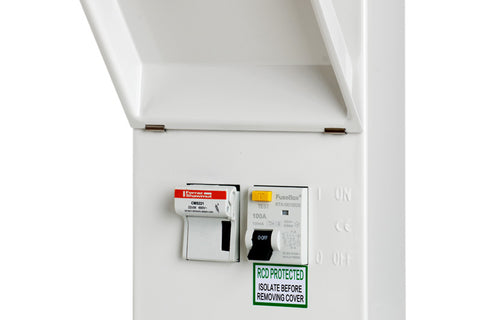What is an MCB and how does it work?
MCBA MCB (Miniature Circuit Breaker) is an electromechanical device made to protect electric circuits from over current. Over current is the technical word for when an electrical fault occurs which is caused by either overload or a short circuit. |
When MCBs were first made they improved the functionality of consumer units. They are pretty robust so are usually not destroyed during over-current so are reusable. Although if there ever was a fault you will always want a fully qualified electrician to check it out and if necessary replace the MCB. They are also much easier to use, offering the convenience of 'on/off switching' for circuit isolation and since the conductor is housed within a plastic casing, they are much safer to use and operate.
It is important to note that MCBs do not protect humans against electrical shock caused by 'earth leakage'. This service is provided by RCBO’S and RCD’s.
An MCB has three principle characteristics, Amperes, Kilo Amperes and Tripping Curve
Overload Current Rating - Amperes (A)
An overload will occur when too many household items are installed on one circuit (mcb). When this happens all of those items will use more of an electric current than the cable an MCB is designed to take. Most commonly this happens in kitchens due to the amount of appliances a household has in this room (Toaster, Kettle, Dishwasher, electric hob, microwave, blender etc). When these items are switched on at the same time and drawing a larger electric current the MCB protects the kitchen sockets will cut the power to prevent overheating and fire within the cables.
Short Circuit Rating - Kilo Amperes (kA)
A Short Circuit happens as a result of two specific scenarios. Either a fault within the electrical circuit somewhere or one of your appliances has a fault. A short circuit can be much more dangerous than an overload current because it occurs when there is a direct connection between the live and neutral conductors. Without the resistance provided by the normal circuit integrity, electrical current rushes around the circuit in a loop and multiplies the amperage by many thousand times in just milliseconds.
Typical Uses for Domestic MCBs
Every single installation is different and should always be designed and installed by a fully qualified electrician. This is simply a guide to what the different amperages of MCB’s are usually used for.
- 6 Amp - Standard lighting circuits
- 10 Amp - Large lighting circuits – These are now much less common due to the rise in LED lights and technology
- 16 Amp and 20 Amp - Depending on the power rating these are commonly used for boilers
- 32 Amp - Power circuit or sockets
- 40 Amp - Cookers / electric hobs / small showers
- 50 Amp - 10kw Electric showers / Hot tubs.
How an MCB works
Overload Protection – Is provided by the Bi-Metallic strip within an MCB. During continuous over-current the strip is heated by an electrical charge, when this happens it releases the switch of the MCB to ‘knock off’ the circuit.
Short Circuit – If there is a sudden rise in electric current this this will cause the tripping coil to strike the trip lever causing an immediate process which will break the circuit and stop a dangerous situation from occurring.
Tripping Curve – The trip curve of an MCB’s (B, C, D, K and Z curves) tell us about the trip current rating of Miniature Circuit breakers. Trip current rating is the minimum current at which the MCB will trip instantaneously. It is required that the trip current must persist for 0.1s. The MCB trip curves, also known as I-t tripping characteristic consist of two sections viz, overload section and short circuit section. Overload section describes the trip time required for various levels of overload currents and the short circuit section describes the instantaneous trip current level of MCB.
Type B MCBs are used in domestic circuit protection where there is little need for surge permission. Any large surge in a domestic environment is likely to be the result of a fault, so the amount of over current allowed is relatively small. B Type MCBs trip between 3 and 5 times full load current, so a 6amp MCB with a B curve will trip between 18a and 30a, depending on how long the over-current lasts, but roughly between 10 and 8 seconds.
Type C MCBs trips between 5 and 10 times full load current and are used in commercial and light industrial environments which may feature large fluorescent lighting circuits, transformers and IT equipment such as servers, PCs and printers.
Type D MCBs are used in heavy industrial facilities such as factories using large winding motors, X-ray machines or compressors. Due to the large potential surges they trip between 10 and 20 times full load current. A 10 amp D Type MCB therefore trips between 100amps and 200amps.












